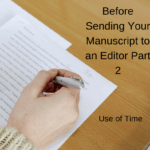We'd love to have you access this content. It's in our members-only area, but you're in luck: becoming a member is easy and it's free.
Already a Member?
Not a Member Yet?
Clean up your use of time. This second post on self-editing revolves around the use of time. Proper use of time is crucial to understanding a memoir.
Note from the Editor: This second installment of Before Sending a Manuscript to an Editor series offers basic editing tips around time use of time. For Part 1: Self-Editing Techniques Click here. For Part 3: Time Sequencing and Flashbacks Click here
Clean Up Your Use of Time
This second post on self-editing revolves around the use of time. In the next post, I will write about time sequencing and flashbacks.
1. The historical present looks like the past, but it isn’t.
What tense are you going to use to narrate your story?
[Free Membership required to read more. See below. ]
 What would happen to the memoir conversation if…
What would happen to the memoir conversation if…
- …you took a moment to present this informative post to your friends and family by linking this article on your social media? Just a click. It’s so easy.
- …you reposted this article on your own blog or website? It’s free and you’d both have some valuable content to boost your blog’s reputation and you would be providing your readers with valuable guidance. For the best procedure on how to do this, click here.
- …you subscribed to our YouTube channel?


No comments yet.